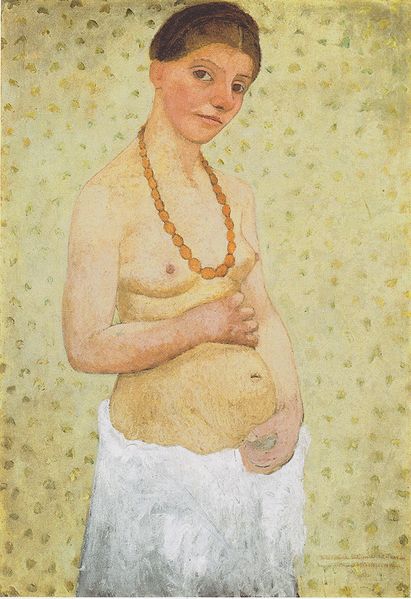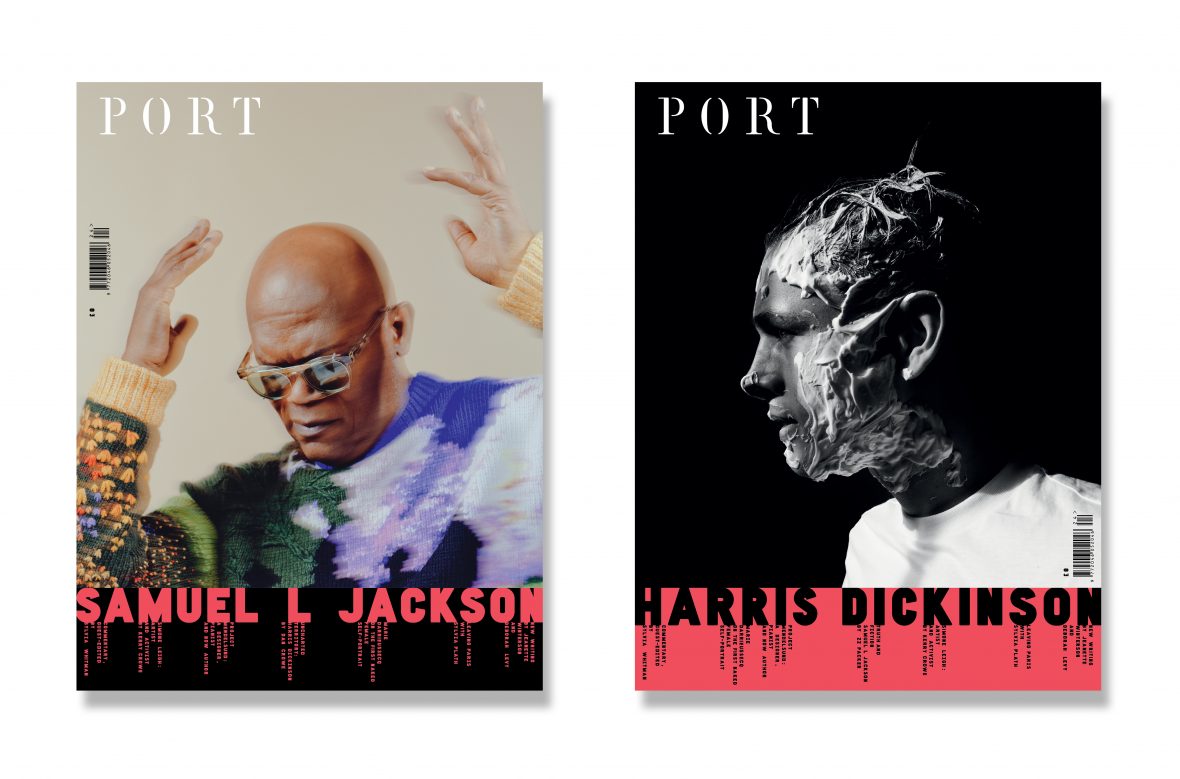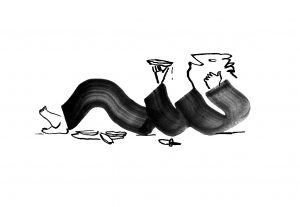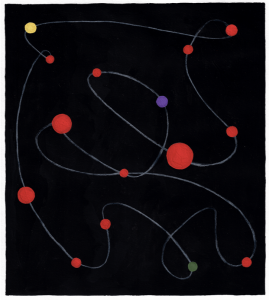From issue 24, Sylvia Whitman at Shakespeare & Company selects a short essay by French novelist Marie Darrieussecq on the painter Paula Modersohn-Becker, the first woman artist to paint a nude self-portrait

The works on display in the basement of the museum are by women. The ceiling is low and the lighting is bad. Nowhere ever before have I seen to what extent women’s art is considered to be inferior to art. Upstairs, well lit: Van Gogh, Cézanne, Gauguin, Matisse, Picasso, Braque, Kirchner, Nolde, Kandinsky, Klee. Downstairs, in the shadows: a mess of statues from antiquity mixed up with contemporary videos. Goddesses, mother- and-child paintings, queens: the only connecting thread is that these works are by women or represent women.
Hidden, out of the way, behind a huge TV, is Paula’s masterpiece, Self-Portrait with a Camellia Branch. The situation is all the more perplexing given that the museum makes use of this self-portrait in its publicity materials: it floats vertically on a two- metre-high banner in the main street.
In reality, the painting is small. Sixty centimetres by thirty.
She stares at us.
Such suffering, says Michel.
A very sad expression, agrees Hans-Jürgen.
The two men even wonder whether they could glimpse tears at the base of the shining eyes.
She has chosen to paint herself backlit. She leaves the viewer in the light. She seems to have the shadow of a smile on her face. But two furrows turn down the corners of her mouth. There are dark circles under her eyes. Her tulip-shaped hand holds a camellia branch, and she wears a heavy amber necklace. She is frowning slightly, concentrating.
She is painting, that’s what I think. Which does not discount other interpretations: bitterness, disappointment in marital life, artistic isolation. But she is not settling any scores here. Her gaze is primarily fixed on her own painting and on the mirror where she is examining the shape of her features.
It is a self-portrait of a woman painting.
It is this self-portrait that the Nazis chose, along with another self-portrait, a full-length nude, in order to denigrate her work as part of the modernist, degenerate art, Entartete Kunst movement.
This Worpswede artist, risen to fame after her death, is a huge disappointment. Her vision is so lacking in femininity, and so vulgar… Her work is an insult to German women and to our farming culture… Where is the sensitivity, the essence of the feminine-maternal spirit?… A revolting mixture of colours, of idiotic figures signifying farmers, of sick children, degenerates, the dregs of humanity.
In Paula’s work there are real women. I want to say women who are naked at long last: stripped of the masculine gaze. Women who are not posing in front of a man; who are not seen through the lens of men’s desire, frustration, possessiveness, domination, aggravation. Women in the work of Modersohn-Becker’s are neither coquettish (Gervex), nor exotic (Gauguin), nor provocative (Manet), nor victims (Degas), nor distraught (Toulouse-Lautrec), nor fat (Renoir), nor colossal (Picasso), nor sculptural (Puvis de Chavannes), nor ethereal (Carolus-Duran). Nor made of ‘pink- and-white almond paste’ (Cabanel, whom Zola made fun of ). With Paula there is no getting-even at all. No sign of rhetoric, or judgment. She shows what she sees.
And also: real babies. The history of art has given birth to countless versions of a horribly rendered little Jesus at the breast of a sceptical Madonna. A face like a monkey, an old man’s neck, suckling that conjures up at best a cow, at worst a game of carom billiards – one red ball and two white balls. No, the babies in Paula’s paintings are babies I have seen in the flesh, never in paintings. The wide-eyed, concentrated, almost fixed gaze of the little person sucking. The hand on the breast, or the closed fist. Just a crease for a wrist. Floppy neck. Plump legs without muscles. Arms that are sometimes thin. Ruddy cheeks, or pale, but never the same complexion as adults. And, around them, Paula’s oranges, round and full.
When little Elsbeth touches Paula’s breasts in the bath and wonders about them, Paula replies lyrically, ‘Breasts hold a wonderful secret.’ The origin of the world: right there in her breasts. It’s already scandalous that little humans come out of women’s vaginas, but that breasts are used to provide food, well, that amounts to theft, misappropriation. It’s hard to picture Manet’s Olympia with a newborn at the breast. As for the Virgin’s vagina, now we’re entering the realm of madness.
I don’t know if there is such a thing as women’s painting, but men’s painting is everywhere. When Paula visits the Louvre, the paintings of only four women artists are on display: Élisabeth Vigée Le Brun, the first woman to have graced the walls of the museum; Constance Mayer and her allegorical paintings; Adélaïde Labille-Guiard and her portraits done in pastel; and Hortense Haudebourt-Lescot, a more recent woman artist, whose work was exhibited in the Louvre at the beginning of the 20th century. In a letter from Rilke to Clara about the 1907 Autumn Salon, he talks about a whole room devoted to Berthe Morisot, and a wall devoted to Eva Gonzalès; it was sufficiently unusual for him to have mentioned it. Whether it’s in museums or galleries, there are inordinately fewer women painters exhibiting than women being exhibited, and the latter are very often naked. And when, in the reign of Napoleon, Constance Mayer painted naked men, she was greeted with boos and jeers.
They paint women. ‘They’ implies here the universal masculine pronoun, centuries of the masculine gaze. In the spring of 1906, Paula is reading The Masterpiece by Zola. In this novel, inspired by Cézanne, the woman, the model, grows older; her flesh sags and her painter husband comments that “pouches of fat were forming under her armpits”. By the end of the novel, the woman is naked, ashamed, abandoned in the icy studio: “She lay there, as if dead, like a white rag, miserable, done for, crushed beneath the fierce sovereignty of Art.”
When Paula paints nudes, a century after Constance Mayer, no one dreams of rebuking her for her immodesty. She was able
to learn anatomy without having to go into hiding, and she was not alone: the female students of the art academies she attends, as well as her contemporary Suzanne Valadon, all work on nudes. But to go from there to painting herself nude…
Her most famous self-portrait, the one people talk about when they talk about her, is at the Paula Modersohn-Becker Museum in Bremen. She is naked to the waist, standing three-quarters on, with a big amber necklace and small pointed breasts. Her belly is swollen. Four or five months pregnant. Although she was not in the habit of writing on the back of her canvases, here we find these words: “I painted this at the age of thirty, on my sixth wedding anniversary, PB.”
But the dates are impossible to determine. On the 25th of May 1906, Paula was not pregnant. A month earlier, she was specifically explaining to Otto that a child was not on the cards now, and not with him. And yet here she is, holding her belly in that proud and protective gesture that many pregnant women have.
The Modersohn-Becker experts, all 30 of them, debate the issue. They bring up her diet. Too much cabbage and too many potatoes. The self-portrait of a bloated woman: care for a bit more soup? But she could just as easily have been imagining her- self pregnant. Making a game of sticking out her belly, arching her back, her navel protruding. Just to see. The self-portrait as auto-fiction. She paints herself as she would like to be, and as she imagines herself: she paints an image of herself. Beautiful, happy, a little bit playful.
And, take note: It is the first time. The first time that a woman has painted herself naked.
The gesture of taking her clothes off and setting up in front of her canvas and going ahead and doing it: Here is my skin; I’m going to show my belly, and the shape of my breasts, and my navel… The nude self-portrait of a woman, one-on-one with herself and the history of art.
Is it because models are expensive? Is it deliberate? This healthy, sporty, pretty, well-rounded, nudist German woman loved her body. The act of painting herself naked has nothing to do with narcissism; it is work. It is all there for her to do. Using either a mirror or a photograph; all there for her to discover. I don’t know if she is aware of it: of being the first one to do it. In any case, she always looks happy naked.
Rainer Maria Rilke
‘Requiem for a Friend’
For that is what you understood: ripe fruits.
You set them before the canvas, in white bowls,
and weighed out each one’s heaviness with your
colours.
Women too, you saw, were fruits; and children,
moulded from inside,
into the shapes of their existence.
And at last you saw yourself as a fruit,
you stepped out of your clothes and brought
your naked body before the mirror, and you
let yourself inside,
down to your gaze, which remained strong, and
didn’t say: This is me, instead: This is.

This article is taken from issue 24. To buy the issue or subscribe, click here




